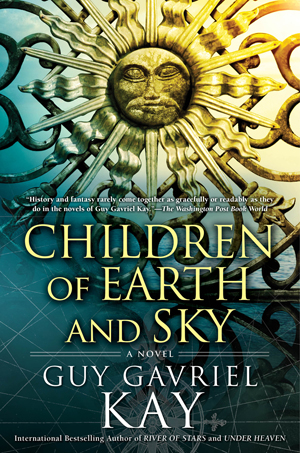Guy Gavriel Kay’s work has been described as “history with a quarter-turn to the fantastic”: It’s almost what you remember learning about in school, but overlaid with a new intrigue, or perspective, that doesn’t exist in our recorded history. Take his new book, Children of Earth and Sky: Set in alternate-history 16th-century Europe—in a city whose canals bring to mind Venice—it tracks the individual ambitions of an artist, an undercover spy, and a band of pirates as well as the looming threat of invasion from an eastern threat that resembles the Ottoman Empire. Bits and pieces that you may have read in books, woven together in a tapestry (to borrow the metaphor of one recent review) or, as I like to think of it, mashed up into a delightful historical remix. Kay has likely read all of the books, as well as some primary sources and other unusual texts—he recently talked to io9 about his involved research process.
For one, there was the question of whether to do more research into actual historical realities, or less:
I don’t think it is a question of more or less, though for me the research phase is always a solid year of reading, notes, correspondence, sometimes travel. One thing the quarter turn does, among other things, is let me make use of some elements I couldn’t have in a straight history. For example, in Children, my ‘emperor’ is inspired by Rudolph II and his court in Prague (alchemists!) which didn’t actually emerge until the late 16th c, about a century after ‘my’ core period. But a chance to open the novel with an eccentric, but underestimated monarch (it is a bit of a MacGuffin, the first chapter) akin to Rudolph was so appealing—and working as I do, it became possible. But that meant research into figures of a later century!
In the earliest stages of researching a book, Kay “div[es] into lots of different lakes” until he hits upon a topic or people that will shape the story. He pulls from primary sources when he can find them in translation, but when that’s not an option, he turns to the most respected authors on that period. In the case of Children of Earth and Sky, Kay was drawn to contradicting accounts of the Ushoks of Senj, Croatian “social bandits” who raided the Ottoman Empire and Venetian territories in equal measure. It was the descriptions of two seemingly different peoples that made him want to learn more:
Many things interested me once I started reading about them. One was the huge gap between their self-identity (there’s that word again!): heroes of the border, proud, honorable, soldiers of the Christian world, defenders of the emperor’s lands and his people … and the perception of them in much of the world as pirates, raiders, violent, destructive, lawless, worthy only of being hanged or beheaded.
That sort of discrepancy is in the primary sources, and it has to fascinate, doesn’t it? I was also drawn to elements of how their women were regarded in Venice and elsewhere: as being as violent and dangerous as the men, hacking off limbs from slain enemies to drink the dripping blood in the belief that this would make their children more fierce. (A pretty classic legend/libel, in fact.) Their women were also ‘rumored’ to have magic, controlling the winds among other things. That gave me ideas.
Finally, they were just so damned cool in how they operated, with small, quick boats, raiding through mountain passes inland. They are only a component of the novel, but they were the starting point, yes.
Charlie Jane Anders identified a recurring theme in Kay’s books: the clash of civilizations. In explaining how it was meaningful to him, Kay revealed more about the kinds of stories he tracks down:
I’m drawn to writing about times and places on the cusp of transition, of one kind or another. It allows for (creates!) legitimate drama, and characters forced to cope with those transitions (successfully or not). Borderlands have always been, for me, compelling in that way, and in Children I make this explicit: what living on the borders can do to people. And in the novel the borders are shifting—as the boundaries and margins and cultural definitions of our world are in flux. So of course the past has things for us to think about. I’m always wary, though, of proposing clear ‘lessons’. I don’t want to be that didactic. (I’m more likely to note in the books how one can draw the wrong lessons from the past!).
Read the rest of the interview at io9!










